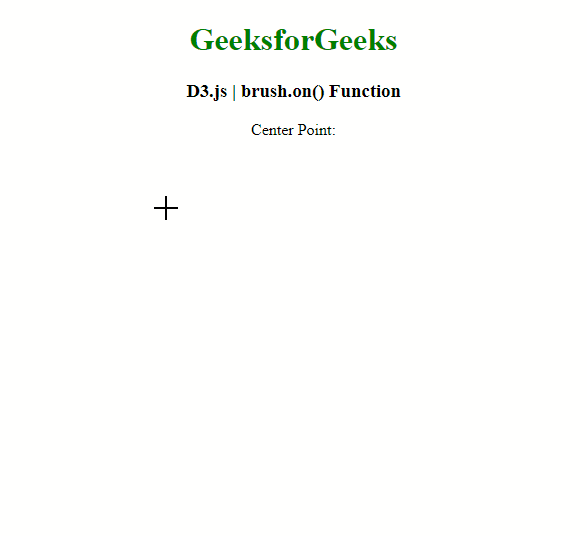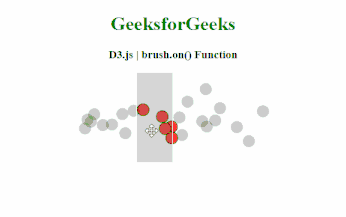D3.js中的brush.on()函数用于为指定的类型名设置事件侦听器并返回画笔。
用法:
brush.on( typenames, listener )
参数:此函数接受上述和以下描述的两个参数:
- typenames:它是包含一个或多个用空格分隔的类型名称的字符串。
- listener:它是用作指定类型名称的事件侦听器的函数。它是一个可选参数。
返回值:此函数返回要使用的画笔。
以下示例程序旨在说明D3.js中的brush.on()函数:
范例1:
HTML
<!DOCTYPE html>
<html>
<head>
<script src=
"https://d3js.org/d3.v4.min.js">
</script>
</head>
<body>
<center>
<h1 style="color:green;">
GeeksforGeeks
</h1>
<h3>D3.js | brush.on() Function </h3>
<p style="color:green;">Center Point:</p>
<p style="color:green;" id="p"></p>
<svg width="300" height="300" id="brush">
</svg>
<script>
// Select the SVG element
d3.select("#brush")
// Create a brush
.call(d3.brush()
// Use the brush.on() function
// to set the given event listener
.on("brush", geekBrush)
.extent([[0, 0],
[300, 300]]
)
);
function geekBrush() {
const sel = d3.brushSelection(this);
// Select the paragraph element
var p = document.getElementById("p");
// Calculate the center point
// to be displayed
var pt1 = sel[1][0] - sel[0][0];
var pt2 = sel[1][1] - sel[0][1];
p.innerHTML = "( "
+ pt1 + ", " + pt2 + " )";
}
</script>
</center>
</body>
</html>输出:

范例2:
HTML
<!DOCTYPE html>
<html>
<head>
<script src=
"https://d3js.org/d3.v4.min.js">
</script>
<style>
circle {
fill-opacity:0.2;
}
circle.active {
fill-opacity:0.8;
stroke:green;
fill:red;
}
</style>
</head>
<body>
<center>
<h1 style="color:green;">GeeksforGeeks</h1>
<h3>D3.js | brush.on() Function </h3>
<svg width="400" height="200"></svg>
<script>
var data = d3.range(25).map(Math.random);
// Select the SVG element
var svg = d3.select("svg"),
margin = {
top:0, right:50,
bottom:50, left:50
},
width = svg.attr("width") -
margin.left - margin.right,
height = svg.attr("height") -
margin.top - margin.bottom,
g = svg.append("g")
.attr("transform", "translate("
+ margin.left + "," + margin.top + ")"
);
var x = d3.scaleLinear().range([0, width]),
y = d3.randomNormal(height / 2, height / 8);
var brush = d3.brushX()
// Use the brush.on() function
// to set the given event listener
.on("start brush end", brushmoved)
.extent([[0, 0], [width, height]]);
var circle = g.append("g")
.attr("class", "circle")
.selectAll("circle")
.data(data)
.enter().append("circle")
.attr("transform", function (d) {
return "translate("
+ x(d) + "," + y() + ")";
})
.attr("r", 10);
var gBrush = g.append("g")
.attr("class", "brush")
.call(brush);
gBrush.call(brush.move, [0.3, 0.5].map(x));
var bs = "";
// Define the function to be
// called when the brush is moved
function brushmoved() {
var s = d3.event.selection;
if (s == null) {
handle.attr("display", "none");
circle.classed("active", false);
} else {
var sx = s.map(x.invert);
circle.classed("active", function (d) {
return sx[0] <= d && d <= sx[1];
});
handle.attr("display", null)
.attr("transform", function (d, i) {
return "translate("
+ s[i] + "," + height / 2 + ")";
});
}
}
</script>
</center>
</body>
</html>输出:

相关用法
- PHP Ds\Set add()用法及代码示例
- PHP each()用法及代码示例
- PHP Ds\Map put()用法及代码示例
- PHP Ds\Set first()用法及代码示例
- PHP Ds\Set last()用法及代码示例
- d3.js d3.map.set()用法及代码示例
- p5.js pan()用法及代码示例
- p5.js value()用法及代码示例
- PHP Ds\Map xor()用法及代码示例
- PHP Ds\Set contains()用法及代码示例
- PHP Ds\Set xor()用法及代码示例
- d3.js lch()用法及代码示例
- d3.js d3.max()用法及代码示例
- p5.js hue()用法及代码示例
- p5.js min()用法及代码示例
- p5.js red()用法及代码示例
注:本文由纯净天空筛选整理自SHUBHAMSINGH10大神的英文原创作品 D3.js brush.on() Function。非经特殊声明,原始代码版权归原作者所有,本译文未经允许或授权,请勿转载或复制。
